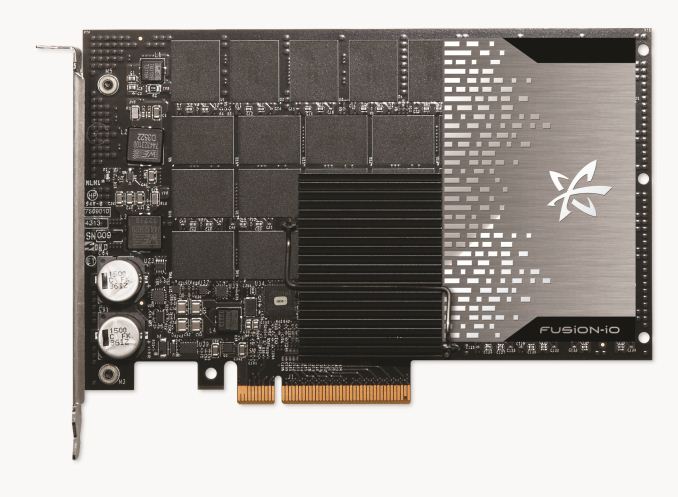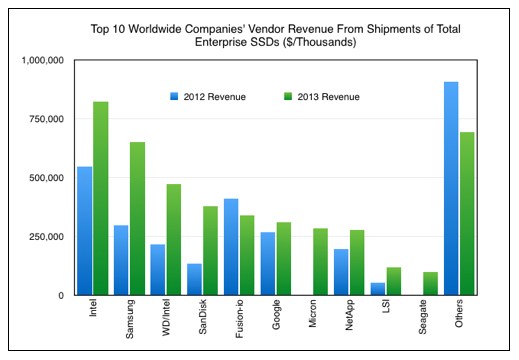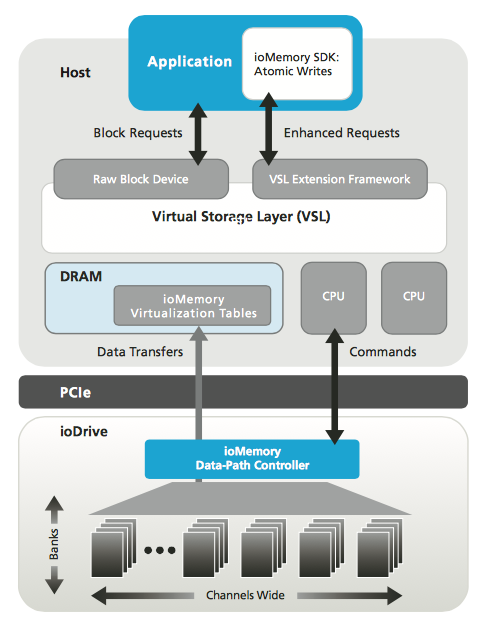The State of SanDisk
by Kristian Vättö on December 5, 2014 8:00 AM ESTThe Enterprise
In mid-July SanDisk announced their acquisition of Fusion-io and the acquisition was completed a couple of week prior to Flash Memory Summit. I posted my initial thoughts when the news hit the public, but I feel that it's worth doing a bit deeper analysis now that I have given it some more thought and discussed it with John Scaramuzzo, senior vice president and general manager of SanDisk's enterprise business.
SanDisk has managed to establish itself as one of the key players in the enterprise SSD space over the past few years. The acquisitions of Pliant in 2011 and SMART Storage Systems in 2013 provided SanDisk with strong expertise and product lineups for SATA and SAS SSDs but left the company without a solid long-term plan for PCIe. I heard Pliant's initial roadmap included plans for PCIe-based solutions as well, but it looks like those plans never materialized.
Up until the Fusion-io acquisition, the Lightning PCIe SSA was the only PCIe solution in SanDisk's enterprise product portfolio, and as a matter of fact that drive is internally a SAS-based design with a PCIe to SAS bridge onboard. In other words, SanDisk had practically zero real PCIe solutions for the enterprise, while at the same time SanDisk's biggest competitors, such as Intel and Samsung, have had PCIe drives for a long while already.
Fusion-io's 3.2TB Atomic Series SSD
Fusion-io's strategy and product portfolio, on the other hand, was a complete opposite. From the beginning Fusion-io has focused on PCIe storage, which dates all the way back to 2007 when the company released its first ioDrive that utilized a PCIe x4 interface and was capable of speeds up to 800MB/s. Not only was Fusion-io early in the market, but the company was also able to garner a few massive and very important clients – the most notable being Facebook and Apple. I don't think it's an overstatement to say that Fusion-io can be considered as the pioneer of PCIe storage because it was the first company to turn PCIe SSDs and storage in general into a large, successful business.
But stories eventually come to an end. The competitive advantages Fusion-io had were its PCIe technology and several high-level customers, but the advantages were lost when the NAND manufacturers stepped into the PCIe territory. It's nearly impossible for a company that has to source its NAND from a third party to compete against another company that manufactures NAND in-house since the latter will always have advantages in cost. While Fusion-io didn't lose its customers to competitors overnight, it's clear that especially Intel and Samsung snagged a share of Fusion-io's business in the past couple of years.
In a nutshell, the acquisition brings SanDisk the long-needed expertise in PCIe storage along with Fusion-io's broad PCIe product portfolio. The acquisition is now a bit over 100 days in and the Fusion-io employees have been integrated into SanDisk's existing teams. Initially Fusion-io's engineering team was separate and worked under Lance Smith, the former President and COO of Fusion-io, but Mr. Smith decided to leave SanDisk and pursue other options. Last week a data virtualization startup Primary Data announced that Mr. Smith has joined the company as the new CEO, which explains his quick departure from SanDisk.
All the engineering talent has now been unified and the team is lead by Mr. Scaramuzzo. With everyone under the same roof, the roadmaps are now in the process of being integrated to bring the expertise together. It will be a while before we see the fruits of the acquisition, but in the meantime the latest Fusion-io products will transition to SanDisk NAND for increased cost efficiency.
But what about NVMe? That has been the hot topic in the industry this year and I bet many of you are wondering what is SanDisk's and Fusion-io's play in that field. The short version of their strategy is that Fusion-io already has a technology called Virtual Storage Layers (VSL), which is essentially a driver/software stack similar to NVMe. The truth is that NVMe isn't really anything new from a technology perspective, but what makes it alluring for many manufacturers is the fact that the NVMe drivers are universal and already supported by the latest operating systems. Technologies like VSL are rather expensive to develop and require expertise because there is no framework available (i.e. everything has to be developed from scratch), but on the other hand an in-house driver like VSL allows for more customization and optimization.
However, that doesn't mean that SanDisk has no interest on NVMe whatsoever. The company sees that as the entry and mid-level enterprise SSDs move from SATA and SAS to PCIe, NVMe will be one of the key factors because of easy and quick deployment. For that market segment the NVMe spec and its limitations are fine – it's only the high-end segment where the benefits of VSL are more prominent. It's actually likely that many manufacturers will turn to custom NVMe drivers anyway for higher and more optimized performance, and in fact that is already happening with Intel providing its own NVMe driver for the P3600/P3700.
Lastly, let's quickly discuss the ULLtraDIMM. I wrote a quick piece on ULLtraDIMM right after Flash Memory Summit, but SanDisk has already scored Huawei as the third ULLtraDIMM partner (in addition to IBM and Supermicro). The first generation product that is currently available is internally based on a pair of SATA 6Gbps controllers, but SanDisk said that a native DDR to NAND controller is possible in the future if the market adopts the new form factor well. As usual, the industry is fairly slow in adopting new form factors, so it's hard to say whether NAND DIMMs will really take off, but it's a very interesting and potentially useful technology.
Final Words
All in all, SanDisk is definitely one of the most interesting NAND companies going forward. USB drives, eMMC solutions, SSDs and even the storage arrays from the Fusion-io acquisition are all built on NAND, which puts SanDisk in a unique position as it's the only NAND manufacturer that focuses solely on NAND products. The company can't turn to alternative revenue sources like e.g. Intel and Samsung can, but on the other hand that's also SanDisk's strength as all the know-how and experience in the company is related to NAND in one way or the other.
Ultimately next year will be crucial for SanDisk because it determines whether the company can materialize all the underlying potential from the Fusion-io acquisition and become a serious competitor to Intel and Samsung in the enterprise space. The pieces are definitely there, so it's just a matter of execution now.














132 Comments
View All Comments
Runamok81 - Saturday, December 6, 2014 - link
My chief concern here is not with an improper vendor relationship. The relationship is fine. I understand Anandtech will NEED vendor relationships to continue providing stories about new technologies. It's not about that. It's about the content. I read the story. This is all FMS had to offer? Nothing about super fast PCIe drives? NVMe? SanDisk didn't send any engineers to talk about how their acquisition of FusionIO is going to make for some new kickass products? No, they only sent the B team marketing crew to give SanDisk's account of their own market challenges and the projected cost of Toggle NAND? Who cares? Don't you think it's a bit presumptuous and naive to think that our "marketing ideas" --and don't delude yourself.. that's what you asked us for-- are going to somehow outfox the prevailing market forces? No, sorry. Bootstrap up and lower Prices or increase capacity / speed. I'd much rather read about those types of advances. Until then, I could care less about "the state of Sandisk"Kristian Vättö - Saturday, December 6, 2014 - link
I did talk about SanDisk's NVMe strategy on the second page, but you have to understand that no company is just going to spill out all their secrets and roadmaps. John is the head of the enterprise team (including engineering) while Kevin leads the client side, so neither of them is part of a "B team marketing crew".Runamok81 - Saturday, December 6, 2014 - link
I get that you're establishing credibility, but I care as much about John's and Kevin's titles as they do. Where's the news here.. and what is this Page 2? What Page 2? .. *looks* oh ... OH! Well, then, uh.. that uh explains a lot. *readingreadingreading*...NVMe..FusionIO...UltraDIMM.....*Final Words... ffffffffffffffFFFFUUU!I owe you one beer. I'll go bang my head on rock. Thank you.
Runamok81 - Saturday, December 6, 2014 - link
Also, thanks for replying to me. Sorry for being an ass.eanazag - Friday, December 5, 2014 - link
The problem is the OEMs. They let accounts run product development and wonder why the experience sucks. OEMs have their heads up their ___es. There is no good reason why Apple's market share has risen so much on the PC. The reason is because they have innovated AND marketed. They add something and tell why it's good. Apple is not perfect at all, but they haven't ruined their premium branding.HP bought Voodoo and killed the brand.
Dell bought Alienware, but didn't kill the brand. Dell hasn't done great at promoting it either. Dell has XPS, but lacks the balls to standardize SSDs in that series. Partially because of capacity. Whereas Apple has the fusion drive (128GB SSD + 1TB HDD). This is the idea that will enhance adoption in cost sensitive areas. MS Windows needs to help the OEMs out here as Intel has already done their part.
Samsung's product lineup is asinine. I looked at their 900 series laptop about a year or two ago and it had that software caching. I think it was an 8GB cache.
Lenovo does decent in product features. I just don't trust a totally China owned company. I don't trust the others much either, but Lenovo even less.
Sony had great battery life before Haswell and Broadwell, but who knew about it. Their service was meh.
Speed is not the only benefit of SSDs. Durability is another when it comes to drops. PC OEMs have jacked up the prices too high for the SSD upgrades. It is often cheaper to buy and upgrade yourself and save money then the upgrade fee Dell was asking and you get the retail bells and whistles that Samsung provided (software utility). Intel did a crappy job of getting OEM wins for their SSDs in the client space, which I can't explain.
I have ensured all the PCs I support have SSDs in them as we have replaced since 2009. It makes my support call much faster. 4 year old PCs aren't total dogs in the last year.
Take note PC OEM an AMD APU plus an SSD is a perfect low cost laptop. AMD CPU performance is almost good enough; the GPU performance is good enough. Add a decent screen 1600x900 is enough to differentiate in this current market.
Apple has been first to PCIe SSDs after dropping HDDs in their laptops altogether. Apple will lead the pack in WiFi AC spec roll out. Apple has made Intel worried that they would put Arm cores in their notebooks, so Intel has been driving down power usage. Who is using the overpriced Crystalwell SKUs? Apple. Crystalwell is a gem that Intel has priced too high and then keeping it from the channel was nonsensical too. Apple is the reason why PC OEMs even consider putting high res and IPS displays. I have pulled apart an Apple device (x86) or two and I like the build quality. I don't like non upgradeable innards especially on the Mac mini; that was uncalled for. The Mac Pro is priced way too high.
Congratulations PC OEMs! Your crappy build quality has made Apple's hardware seem reasonably priced.
The real problem is people are dumb. They buy something and then complain about how slow it is. You tell them that they could have upgraded and you get a blank stare. The black Friday deal didn't have an SSD.
All over the place when I'm rantin' and rollin'.
azazel1024 - Friday, December 5, 2014 - link
Honestly I don't know that there is a way, other than doing what they are now, pushing the prices further down. I love cheaper of course, but I am waiting for the tipping point of capacity versus price where it makes sense to replace bulk storage with SSDs instead of using HDDs.I don't need much, but I still have ~2TiB of storage and call it 3TiB for short/medium term growth (say, 24 months of growth capacity). Times 3 for desktop, server and then backup to mirror my data. At current prices, that is around $3,000. Also many drives. My price point would be much closer to $.10 per GB instead of .30-.35 per GB. At $1,000 for all of it, I could seriously consider it. Take out the backup and leave that spinning disk and for my desktop and server, ~$600 for both for the reliability, long life, low power, no-defrag requirements and high speed of SSDs and I'd jump on SSDs for bulk storage.
Still 3-5 years away from that the way things are going. Until then, all you'll see me do is the "minimum" to get my OS and applications off spinning disk (which I've already done). 120GB SATA3 and 60GB SATA2 drive in my desktop, 128GB SATA3 drive in my laptop. Maybe in a future upgrade I'll get a couple of 128GBs in my desktop in RAID0 for performance. Maybe.
eanazag - Friday, December 5, 2014 - link
Where are Sandisk's OEM wins with SATA drives in the client space? Why the hell is Dell packing Liteon SSD drives in their Latitude lineup? Dell uses Samsung also, but I get that. Apple has been known to roll with Samsung and Toshiba SSDs. I don't see why Sandisk couldn't have done better in the OEM space.OEMs need to up the ante on at least one of their product lines and then communicate that to customers. OEM to customer: "We're including SSDs, display, and build quality. Hey! We're even going to support you 18-24 months with North America support and a replacement device in a week as opposed to 3-4 weeks. In this series you can expect cutting edge tech, quality, and support." What PC OEM is doing that? That is why they fight over the bottom. There has only been cutting corners over the years.
metayoshi - Friday, December 5, 2014 - link
"This is actually the part where we ask for your, our readers, help. What is it that we or manufacturers like SanDisk could do to boost the SSD penetration in the market?"It definitely has to be getting the OEMs to start dropping HDDs. I mean, you mention the masses, and I believe it's really just that. The masses don't go to Newegg or Fry's and buy an SSD to upgrade their systems, and they also don't go to those sellers to build their own computer. They go to Best Buy, Target, etc. and buy the cheapest pre-built system they can find, and as long as it does Office and go on the internet, they're pretty much set. They don't care that it has a 5400 RPM or 7200 RPM HDD or SSD in there. They see 500 GB, and believe it's good for them.
At any given capacity, an HDD will always be significantly cheaper, and that's where OEMs will go because that's where their systems sell. Just as you said, they also use low res 1366x768 TN panels because it lowers the price even more. We call it a bad user experience. To the masses, it's just another cheap laptop that can do Microsoft Office and go on the internet. That's all they need. It's not necessarily a bad thing, but that's what's on the market today.
In the end, it'll be OEMs that will cause the client market to start adopting SSDs at a higher rate. Once OEMs can offer products in the $200-$500 and only have SSDs, that's when client SSDs will really boom. For now, I think it's expected that only enthusiasts or people willing to spend closer to $1000 or more on a system will be getting SSDs by default. As SSD prices go down, that may probably change. Even Apple is providing SSD only options for its recent Macbook Air/Pro line, but they are still in the $1000 and above range. Eventually, it should reach the Dell Inpirons and HP Pavilions of the future, and that's what the masses will get. I don't believe HDDs will go away entirely, as they will always be cheaper for more capacity, and that's where big datacenters are moving and external storage is always great, but I can see SSDs becoming cheap enough that the consumer products may just be SSD only. We'll see though. It's only a matter of time when SSDs become really cheap. I just don't know how long that time is.
toyotabedzrock - Friday, December 5, 2014 - link
The problem is that on the low end machines you do not have any SSD options. Even on midrange machines there is no SSD option.Second problem is uefi and how do you move your laptop to an SSD without loosing recovery partitions etc. With older systems I only had to worry about Windows activation.
Third, people still want big storage, where are the 128gb SSD / 1TB drives and why is MS not implementing software to handle the drives as one?
toyotabedzrock - Friday, December 5, 2014 - link
One last suggestion rebrand the prosumer products as Fusion io. When I think of sandisk I think of cheap thumb drives and memory cards.